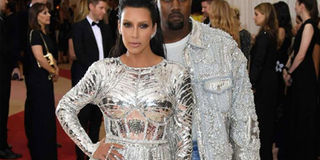Fashion and museum: An exciting mix

This file photo taken on May 2, 2016 shows Kim Kardashian West (L) and Kanye West attending the "Manus x Machina: Fashion In An Age Of Technology" Costume Institute Gala at Metropolitan Museum of Art in New York City. PHOTO| AFP
What you need to know:
- When a curator brings in their objectivity, and who qualifies as a curator in this case, is the approval based on art, history, design or culture?
- This is critical because it should not seem like a designer is promoting themselves.
The last time I went to the museum I was around it – for Hairtage, lunch at the cafe and the Storymoja Festival.
I never once went inside the Kenya National Museum. I think I may have seen a couple of plays there too including Patricia Kihoro’s “The Single Life”. In the movies when someone wants to have an intelligent date, museums and galleries top the list. Here though, the question still lingers. Is there a place for fashion in a museum?
Ideally, fashion exhibitions and museums tend to be tied to a major event, such as the theme of the Met Gala, which has a designated Costume Institute making showcases that much simpler, or are retrospectives of designers like Dior and McQueen who have since passed on and left a legacy worth curating.
They can take years to put together, such as Hubert de Givenchy’s which added up to an entire decade. Fashion houses that end up exhibiting have a legacy that goes as far back as 75 years, with a rich history of landmarks or inspired by the deeply controversial.
Some, like Chanel’s, are self-funded. It therefore begs the question, does our fashion have enough of a legacy to be archived? When it comes to museums and fashion, a growing popular trend in Asia, Europe and America, do we have what it takes? Inside our Ankara-drenched sense of style needs to be something our clothes say about our history, culture and identity.
It then raises the challenge of curating an exhibition. If a museum wants to stock up it will need either donations from the public, who contribute what they own, or for fashion houses to dig into their archives. Then again who decides what is exhibited? Is it the fashion house or the curator?
When a curator brings in their objectivity, and who qualifies as a curator in this case, is the approval based on art, history, design or culture? This is critical because it should not seem like a designer is promoting themselves. There is a fine line between significance and informing or educating. There is a bit of a debate as to whether designers who are museumed should be alive or dead. Then again, take Hubert de Givenchy. It took a decade for him to collect donations from his clients in order for him to constitute an exhibition.
I do wonder as well if an exhibition in our local museums has to be specifically about local content. There is an Australian museum that showcased Japanese fashion.
A GLOBAL VILLAGE
Such things remind us the world is a global village so we do have a stake in learning about others and their culture. Besides, any fashion showcase includes a great deal of research to give it context and feed curiosity not to mention illuminating similarities and differences as well as tolerance. For instance, when Alan Donovan took the African Heritage collection on tour, he started at Alliance Francaise.
This exhibition of textiles largely from West Africa did not simply focus on fabric, it gave insight into a way of life and royal legacies and accoutrements and the Kingdom of the Ashanti. Also, say a third generation family donated saris and kurtas.
Would that qualify as Kenyan?
Business now need to be creatively run, and museums are no exception. Fashion is intriguing and increasingly entertaining to the masses. Galleries such as Circle Art are more amenable to fashion showcases, retrospectives and exhibitions. But of course if a museum had the “superhero movie” of exhibitions they would need to promote the heck out of it.
It would also be the kind of show that could easily seem to be a commercialisation of art, and by extension, fashion. There will be need for corporate involvement, funding, sponsorship, collaborations and partnership.
The flip side being museums are not exactly drowning in publicity. Fashion is an intriguing museum experience. It is a testament to, and can spark conversation on class, gender, sexuality, identity, the female body, evolving masculinity, politics, technology, photography, cosmetics, beauty and education.





